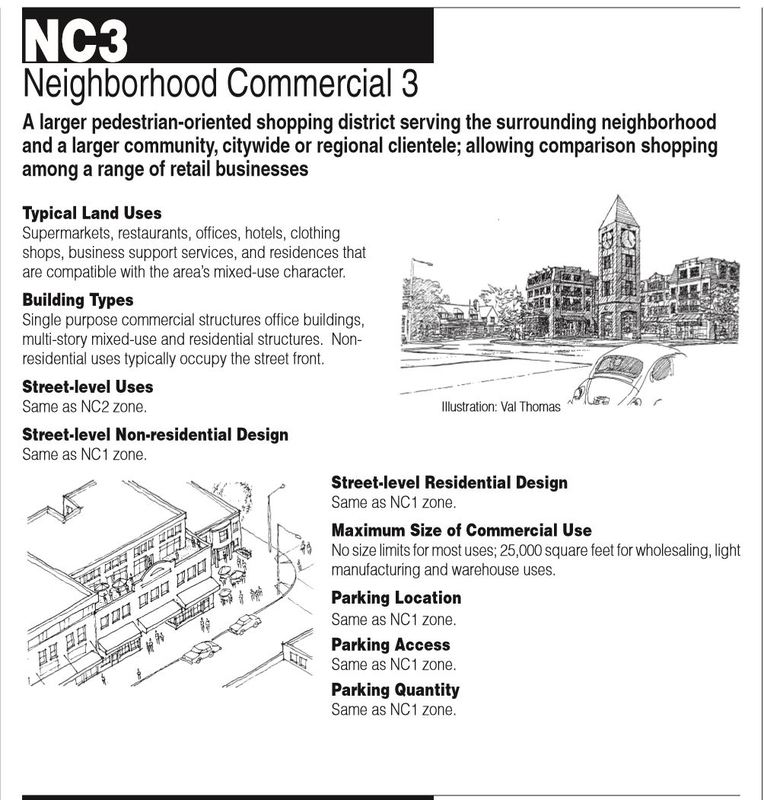Site report 4

Potential development map from Residential Market Analysis paper, showing the areas of block 04 that are prime for development. (U-District Urban 2013)

Parameters layed out by the City of Seattle for the NC-3 zone, which covers most of block 04. (Seattle's Commercial 2016)
Block 04 is defined by its two main historical uses: a residential and commercial area. For this reason, it is important to consider both the Residential Market Analysis and Retail Study of the University District done in 2013. The Residential Market Analysis (2013) places block 04 as near the center of its development focus zone, and lists the commercial area alongside 45th and SE corner single family homes as prime for development, grading both at a less than 50% improvement value to property value ratio. More broadly, this study highlights the need for additional housing in the U district and calls for a diversification of housing options to serve a greater range of residents while keeping prices affordable, a challenge considering the property value boosting effects of the upcoming light rail station (U-District Urban 2013). They concede that that large apartments capable of hosting families within high rises are currently not economically feasible, putting restraints on their goals of diversification. Nevertheless, high rise structures as solutions to improve housing capacity are supported by this study, which could have profound impacts on block 04 and the neighborhood as a whole. While block 04 currently houses exclusively commercial ventures, it is zoned to possibly accommodate mixed use apartment buildings and other large residential structures. With its central location and numerous spots marked as prime areas for development (ibid), this block stands to undergo massive changes as residential needs increase to meet the growing non-student population. The Urban Retail Study (2014) identified block 04 as being within the primary trade zone of the University District, though outside the main commercial corridor of the Ave. This study also identified several target markets for retailers within the commercial zone, most of which include urban-inclined individuals, while mostly leaving out the needs of students. The recommendation of this study to block 04 would be to cater its retail spaces more to this urban-chic audience. Currently, the block does not meet those standards, as its main commercial center along 45th is made up of cheap restaurants, smoke shops, and a gas station, and is somewhat unkempt.
These studies both lay out a cosmopolitan vision of the University District of upscale housing and retail catering towards affluent, urban-chic consumers, though they still touch on the needs of poorer residents and students. They were both made by research firms commissioed by the City of Seattle with an interest to promote more upscale development driven by the influx of wealth due to the tech boom and educational opportunities provided by the UW. The city stands to benefit greatly from this kind of development as property values are raised and more tax revenue can be generated from an area. Public-private partnerships that are a hallmark of neoliberal city governance have been used to great success in the recent past of Seattle, and the city plans on continuing this trend in the U-district. Neoliberal city planners see the economic growth and competitive advantage gained from dense, upscale urban environments and advocate along with corporate interestsc for policies that promote this trend. Block 04, with its multiple ‘underdeveloped’ lots, including a relatively vacant SE corner, is a prime target for this type of development, evidenced by the modern Roosevelt commons office buildings. The block’s combined commercial and residential characters paired with its strategic location near the center of the U district further increase its appeal to developers.
I believe block 04 will experience greater development, building off the example of the Roosevelt commons, however, I would stress that new high density commercial and residential establishments take the needs of less wealthy people into account and build upon the history of the block rather than paving it over. This block could be a prime location for affordable spaces that blend residential and commercial uses for all income levels. This block offers numerous opportunities to new development, but I would urge that this development is undertaken in a sustainable and mindful way.
